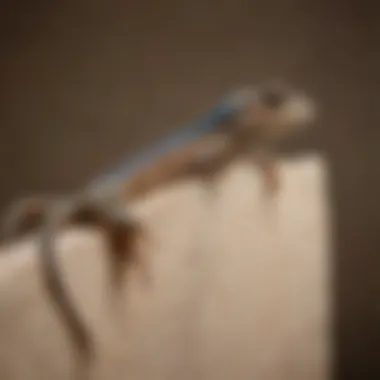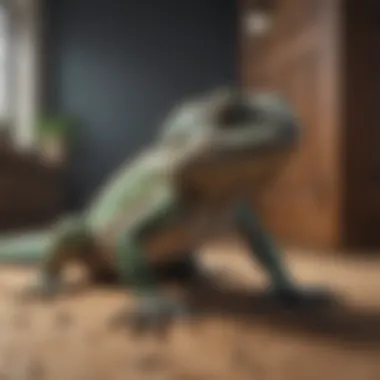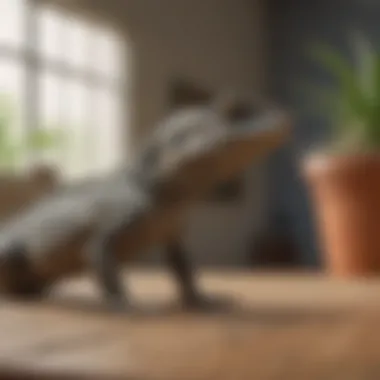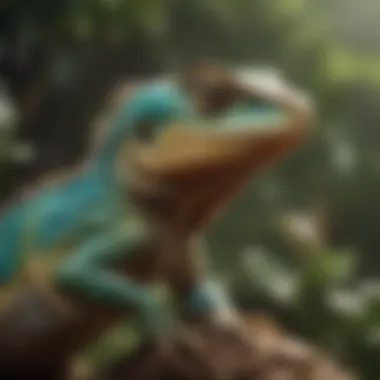Comprehensive House Lizard Pest Control Guide


Intro
House lizards might remain a common sight in many homes, yet their presence can spark various discussions regarding pest control. In many cultures, they are viewed as harmless creatures that perform beneficial roles by controlling insects. However, from another perspective, their existence can bring about worry among homeowners—not just for the potential infestation but also for hygiene concerns. This guide aims to unravel the complexity behind house lizard pest control, aiming to inform readers about their ecological role, behaviors, and potential management methods while promoting humane practices.
Fascinating Facts About the Animal
Unique Characteristics
House lizards mystify many with their adaptability and physical features. Most notable is the common house lizard, scientifically known as Hemidactylus frenatus. This species boasts a flattened body, expansive toes equipped with adhesive pads, and a long yet flexible tail, often used for balance and escape. These characteristics allow them to thrive in diverse environments, including urban settings where they frequently seek shelter in cracks and crevices.
Extraordinary Abilities
House lizards possess remarkable capabilities that allow them to coexist with humans. Their ability to climb smooth surfaces defies common logic, made possible by tiny hairs on their feet that create a van der Waals force. Additionally, they have a unique ability to detach their tails when threatened, providing a diversion to potential predators, although this often results in energy depletion and a survival cost for the lizard.
Behavior and Habitat
Natural Habitats
Typically, house lizards make their homes in warm and humid climates. They prefer areas with ample access to food sources, such as insects and spiders. Often, they can be found in garages, attics, and near doorways where artificial light attracts prey. Understanding these habitats is crucial during pest control efforts, as it might help in devising effective strategies.
Social Structures
House lizards exhibit interesting social behaviors. They tend to be solitary but can establish territories that involve vocalizations and physical displays to ward off intruders. The common house lizard communicates using chirps, which serves to attract mates and establish boundaries. This social structure is vital for their reproduction and survival.
Recent Scientific Discoveries
Latest Research Findings
Recent studies delve into the ecological significance of house lizards. Research conducted at various universities emphasizes their role in pest control, as they significantly reduce insect populations in homes. This insight challenges the notion of seeing lizards merely as pests and encourages a more balanced understanding of their presence.
Breakthroughs in Animal Biology
Breakthroughs in studies of house lizards have also revealed fascinating insights into their physiology. Researchers are investigating their regenerative capabilities, particularly how they can regrow tails after losing them. Understanding this process not only sheds light on their survival strategies but can also inspire advances in regenerative medicine for humans.
Cultural Significance
Animals in Folklore
House lizards hold a spot in various cultural narratives. In some regions, they symbolize good luck and protection. Folk tales often depict them as guardians against evil, showcasing a cultural appreciation that contrasts with their pest status in homes.
Influence on Art and Literature
The presence of house lizards often inspires creative expressions across art and literature. Artists use their imagery to symbolize adaptability and resilience. Such representations prompt a deeper reflection on the relationship between humans and these reptiles.
Understanding House Lizards
Understanding house lizards is crucial for anyone dealing with their presence in domestic spaces. This section elucidates the significance of these reptiles, their advantageous traits, and some potential drawbacks when they inhabit our homes. Grasping their biology and behavior helps in developing appropriate management strategies.
Biology and Behavior
House lizards, often referred to as geckos or skinks, belong to diverse families noted for specific adaptations. Their biological structure includes a unique arrangement of scales, which can vary in texture and color. This diversity can affect their camouflage, making them less noticeable and challenging to control.
Behaviorally, house lizards are primarily nocturnal, becoming active at night. They possess specialized toe pads that enable them to scale smooth surfaces, often favoring cooler areas of the home during the hotter months. Their diet mainly consists of insects and small invertebrates, positioning them as natural pest controllers. However, this feeding behavior also makes them potential carriers of diseases, raising concerns for households with young children or vulnerable individuals.


Ecological Role
House lizards play a vital ecological role. They help control insect populations, reducing the presence of pests like cockroaches and mosquitoes. Their presence in a home can signify a naturally balanced ecosystem, where both lizards and insects coexist. However, the benefits come with a balance. Some homeowners might view the lizard as a nuisance, especially when it intrudes upon personal spaces or leaves waste behind. To appreciate their ecological significance, it is essential to recognize both their contributions to pest control and the challenges they may present to household hygiene.
Common Species
Several species of house lizards are prevalent in various regions. The common house gecko, known for its familiar chirping sound, is widespread in urban areas. Another frequent visitor is the Indo-Pacific gecko, notable for its adaptability to different environments. Each species has distinct behavioral traits and habitat preferences that influence their interaction with human households.
Knowing which species you are dealing with can guide appropriate management techniques. For instance, the presence of a specific species may dictate if a humane removal strategy is feasible or if measures for pest control are necessary. Understanding these species contributes to informed decisions in dealing with potential lizard infestations.
The Dilemma of House Lizards as Pests
House lizards present a complex situation when it comes to their coexistence with humans. While they are often perceived as a nuisance in many households, their ecological benefits provoke a deeper discussion. Understanding this dilemma involves assessing their role in the environment, their behaviors, and when they step over the line from helpful to bothersome. This section aims to clarify these crucial aspects, allowing readers to make informed decisions regarding lizard management within their homes.
Pests or Beneficial Creatures?
House lizards, particularly species such as Hemidactylus frenatus, serve as both predators and prey within their ecosystems. They specialize in controlling insect populations, often consuming moths, roaches, and mosquitoes. This characteristic makes them valuable to humans, especially in regions where these insects can pose significant health risks. Thus, they can be seen as beneficial creatures rather than mere pests.
However, the perception shifts when their presence becomes overwhelming in living spaces. When lizards populate homes in large numbers, their positive contributions can at times be overshadowed by the discomfort they cause. Thus, it is crucial to recognize both sides: as natural predators and as unwanted guests in human dwellings.
When They Become a Nuisance
House lizards begin to cross into nuisance territory when they create disturbances. Factors that contribute to this shift include:
- Excessive Noise: The sounds they make, particularly mating calls during the night, can be disruptive.
- Visible Presence: Frequent sightings in kitchens or living areas can provoke unease among residents.
- Unpleasant Odor: In some cases, lizards can leave behind droppings that contribute to poor indoor air quality.
When these factors occur, homeowners might feel compelled to take action. What was once tolerated as a beneficial aspect of the ecosystem can lead to frustration. Understanding when these creatures become bothersome helps in deciding how to address their presence.
Health Risks Associated with Lizards
While house lizards generally present minimal health risks, there are certain concerns associated with their presence. Some of these include:
- Salmonella Transmission: Lizards, like many reptiles, can carry Salmonella bacteria. If a person handles a lizard or contaminates surfaces with lizard droppings, they may be at risk of infection.
- Allergic Reactions: Some individuals may have allergies to lizard proteins, particularly from droppings or shed skins.
These health considerations underscore the importance of managing house lizard populations effectively. Addressing potential risks while recognizing their ecological roles requires a balanced approach to pest control.
Identifying the Problem
Identifying the presence of house lizards in your home is foundational to effective pest management. Understanding whether these reptiles are merely visiting or have established a population will influence the strategies you adopt for control. Take note that early detection can significantly simplify the management process and decrease the likelihood of escalation into a larger issue. Addressing the problem early allows residents to consider humane methods over more aggressive, potentially harmful options.
Signs of Infestation
Several signs may indicate that house lizards have made your home their habitat.
- Visible Lizards: Spotting a lizard during the day often signals their presence. Observe their behavior; they are generally more active at night.
- Droppings: Lizards leave behind small, dark pellets. These can often resemble minuscule mouse droppings. Finding droppings in various locations, such as corners or near food sources, indicates a sustained presence.
- Shed Skin: Lizards shed skin as they grow. Finding this shed skin can serve as a clear indicator of a house lizard habitat.
- Eating Insects: Observing decreased insect populations can indicate a presence of lizards, as they often feed on other pests such as ants, cockroaches, and flies.
Awareness of these signs allows homeowners to take timely action, preventing the situation from worsening.
Understanding Lizard Behavior in Homes
Grasping the behavior of house lizards is critical for effective pest management. Lizards prefer warmer environments with ample food sources, typically insects. They are nocturnal, which means they are most active during the night. Recognizing this can guide your preventive approaches, especially concerning entry points and food storage methods.
Consider the following behavioral characteristics to help in your management strategy:


- Habitat Preferences: House lizards are attracted to warm, sheltered areas. They favor places like behind appliances, in corners, or near windows where food is accessible.
- Feeding Patterns: Being insectivorous, house lizards will hunt at night. Reducing insect populations will discourage lizards from frequenting your home.
- Reproductive Habits: If there is a conducive environment, house lizards can reproduce rapidly. Understanding this can help you stay ahead of potential infestations.
By familiarizing yourself with these behaviors, you can adjust your home environment to discourage lizard habitation while maintaining control over insect populations.
According to wildlife biologists, the presence of lizards in homes can sometimes indicate an overarching pest issue, typically in the form of insects. Effective pest management thus requires a two-fold approach, attending to both lizards and their food sources.
Preventive Measures
Preventive measures are essential in managing house lizards effectively. These strategies not only reduce the likelihood of an infestation but also create an environment that is less attractive to lizards. Understanding the significance of these measures helps homeowners implement tactics that promote a harmonious living space while minimizing the appearance of unwanted reptiles.
First, it is crucial to recognize the behavior and habits of house lizards. These creatures seek out locations that provide food, water, and shelter. By addressing these needs, homeowners can create barriers that deter lizards from entering their homes. Preventive measures are often more sustainable and humane compared to reactive control methods.
Additionally, engaging in preventive practices fosters awareness of the ecosystem around us. By promoting strategies to coexist with these reptiles, we can appreciate their role in controlling pests like insects, which further contributes to a balanced home environment.
Indoor Strategies
Indoor strategies focus on limiting access and appealing conditions for lizards within your home. Here are some effective practices to consider:
- Seal entry points: Inspect your home for cracks, crevices, and gaps in windows or doors. Use caulk or weather stripping to close these openings. This can significantly reduce lizards gaining access.
- Maintain cleanliness: Keep your living areas clutter-free and clean. Lizards often hide in piles of newspapers or unused items. Regular cleaning reduces these hiding spots.
- Reduce moisture: Use dehumidifiers in damp areas like basements or bathrooms. Lizards are attracted to moist environments. Fix any leaks and ensure proper ventilation to maintain lower humidity levels.
- Manage food sources: Store food securely in sealed containers. This limits the availability of insects, which are primary food sources for lizards. Garbage should also be well-contained, further decreasing attractiveness.
These strategies may seem simple. However, they significantly impact the prevention of house lizard infestations.
Outdoor Strategies
Outdoor strategies are equally important and involve modifying the surroundings to discourage lizards from approaching your home. Consider the following actions:
- Trim vegetation: Keep shrubs and plants well-trimmed. Dense foliage near entry points can provide shelter for lizards, making your home more inviting. Maintain a clear perimeter about two feet away from the foundation of your house.
- Remove debris: Clear any garden debris, rocks, or discarded items where lizards might hide. Regular maintenance of outdoor spaces plays a vital role in reducing potential habitats.
- Install proper lighting: Lizards are attracted to insects, which are drawn to light at night. Opt for yellow insect-repellent bulbs rather than white light, which can help reduce the attraction.
- Control moisture: Ensure drainage systems function effectively. Standing water may create appealing conditions for lizards by attracting insects. Proper landscaping can help with effective drainage.
Implementing these indoor and outdoor strategies allows homeowners to take proactive steps in maintaining their living environments, ensuring a balance between comfort and wildlife management.
Control Methods
Control methods are critical in managing the coexistence of humans and house lizards. Understanding effective practices can reduce the stress of a lizard presence while also respecting their ecological importance. The aim is to balance control measures with a humane approach that ensures the well-being of both humans and wildlife.
Humane Removal Techniques
Humane removal techniques focus on relocating house lizards without causing them harm. These methods prioritize the animal's well-being and often include:
- Live Traps: These devices capture lizards alive for safe relocation. They must be checked regularly to prevent undue stress to the captured lizards.
- Exclusion Practices: Closing off entry points such as cracks and vents in walls, doors, or windows minimizes lizard access to human dwellings.
- Evocation Techniques: Gentle nudging methods can sometimes encourage lizards to leave a space voluntarily. This might include the strategic placement of objects or utilizing light to attract them outside.
The benefits of humane techniques extend beyond compliance with ethical standards. They reduce the risk of any disruption in the local ecosystem because the lizards are not harmed or killed. Rather, they can be removed to a more suitable habitat.
Chemical Control Options
Chemical control can be effective but requires careful consideration of its implications on health and the environment. Here are several options to consider:
- Insecticides: While not directly targeting lizards, these substances can kill insects, which are food sources for lizards, potentially driving them away from your property.
- Pesticides: Specialized pesticides can deter lizards without being harmful to other wildlife. However, choosing the right type of pesticide is crucial to minimize risks.
- Repellents: Various commercial repellents contain chemicals that discourage lizards from entering specific areas. These can be applied to spots where lizard activity is noted.
Nonetheless, an important consideration when employing chemical control methods is their potential impact on human health and pets. Always follow the manufacturer's guidelines, and consider consulting a professional pest control service for safe application.
Natural Repellents
Natural repellents present environmentally friendly alternatives that can safely deter house lizards. Some common approaches include:


- Peppermint Oil: A few drops of peppermint oil diluted with water can serve as an effective lizard repellent when sprayed in areas of high lizard activity.
- Vinegar: A mixture of vinegar and water can disrupt the lizard’s sense of smell and deter them from entering.
- Eggshells: Placing crushed eggshells around areas may create an impression of a predator's presence, leading to lizards avoiding those spots.
Utilizing natural repellents aligns with both sustainability practices and health safety. Regular application is necessary to maintain effectiveness, and these methods can complement other control measures nicely.
In summary, control methods for managing house lizards require a thoughtful approach. Balancing humane techniques, chemical applications, and natural remedies can lead to effective pest control while maintaining ecological integrity.
Long-Term Management Strategies
Addressing house lizard issues goes beyond immediate control measures. Long-term management strategies are essential in establishing a balanced cohabitation with these reptiles while mitigating their potential nuisances. The importance of sustainable practices cannot be overstated. Integrating long-term approaches helps minimize recurring infestations and supports ecological health. These strategies require careful planning, but they can lead to effective and humane management solutions.
Sustainability Considerations
When designing long-term strategies, sustainability should be the cornerstone. Implementing practices that do not harm lizards or their habitats is critical. Consider natural repellents and habitat modification as primary elements.
- Natural Repellents: Use substances like garlic or vinegar, which can deter lizards without causing toxicity. These methods are environmentally friendly and safe for families.
- Habitat Modification: Ensuring that your home environment is less inviting for lizards can significantly reduce their presence. This includes sealing cracks, reducing moisture, and keeping outdoor lighting minimal at night, as lizards are often attracted to insects drawn to light.
Furthermore, involving local wildlife experts to guide on proper handling can enhance these efforts. This respect for ecological balance not only aids in pest control but also fosters an understanding of the lizards’ role within our ecosystems.
Continual Monitoring
Establishing a continual monitoring system is vital for assessing the effectiveness of your management strategies. Monitoring allows you to adapt and modify your approaches based on observable results. Here are a few methods to consider:
- Regular Inspections: Conduct periodic check-ups in and around your home to identify any signs of lizard activity. This could include droppings or discarded skins.
- Data Tracking: Maintain a log of sightings, which will help you note patterns in lizard behavior. Understanding when and where they appear can inform your control methods.
- Environmental Assessment: Evaluate your surroundings for changes in vegetation or pest populations, which may affect lizard presence.
“Regular assessments not only enhance the effectiveness of control methods but also promote awareness about the ongoing relationship between humans and house lizards.”
Legal and Ethical Considerations
The complexities surrounding house lizard pest control extend beyond mere eradication methodologies. Understanding legal and ethical considerations is crucial for responsible management of these reptiles. The implications of our actions on both the lizards and the environment must be thoughtfully examined. This section articulates the various regulations and the ethical obligations tied to the treatment of wildlife.
Regulations on Pest Control
In many regions, regulations govern how homeowners can deal with various pest species, including house lizards. Local wildlife regulations may restrict the methods used for control, including the use of certain chemicals or traps. Often, these laws are designed to protect local biodiversity and prevent potential harms to non-target species.
- Research Local Laws: Before taking any action, homeowners should familiarize themselves with local regulations regarding reptile control. This includes knowing whether any specific species are protected under wildlife legislation.
- Permits and Licensing: In some cases, legal pest removal may require permits or the involvement of licensed pest control professionals. This ensures that measures taken comply with ethical treatment guidelines and legal standards.
Failing to adhere to these regulations can lead to legal repercussions and unintended damage to local ecosystems. Thus, it is important to approach pest control with an informed perspective.
Ethical Treatment of Wildlife
Recognizing the intrinsic value of all species is vital when addressing house lizard pest control. Ethically responsible treatment not only aligns with conservation principles but also enhances community relationship with natural ecosystems.
Considerations for Ethical Interaction
- Humane Methods: Whenever possible, use humane techniques for lizard removal. These methods do not harm the creatures and allow for their safe relocation. Examples include live traps that capture lizards without inflicting injuries.
- Education and Awareness: Promoting awareness about the ecological roles of house lizards can shift perspectives. Emphasizing their benefits—such as natural pest control—can reduce the desire for harmful extermination methods.
- Respecting Habitat: It is crucial to ensure that any action taken does not disturb local habitats or non-target species. By maintaining ecological balance, homeowners contribute positively to their environments.
Ethical wildlife treatment fosters a culture of respect for nature. This not only benefits the lizards but also supports broader conservation efforts in the community.
Finale
The topic of house lizard pest control is essential, as it intertwines the management of a common household nuisance with ecological considerations. A thorough understanding of house lizards leads to more informed decisions regarding their presence in domestic settings. Balancing control efforts with conservation principles is vital for maintaining ecological integrity while addressing household concerns.
Balancing Control with Conservation
In the case of house lizards, one must consider both their role in ecosystems and the reasons they may be deemed pests. Lizards can help control insect populations, making them beneficial to have around. However, when their presence becomes disruptive, mitigation strategies become necessary.
To effectively achieve a balance, the following strategies should be adopted:
- Education about the ecological benefits of lizards is vital. Awareness can lead to a more respectful coexistence with these creatures.
- Humane removal techniques should be prioritized. Using traps or guided relocation methods can reduce stress on the lizards while managing the infestation effectively.
- Preventive measures, such as sealing entry points and reducing hiding places, can minimize encounters without harming the local lizard population.
- Chemical control options should be used sparingly, ensuring that they do not adversely affect non-target species or the environment. It is critical to follow guidelines from trusted resources, such as Wikipedia, to understand the implications of such interventions.







